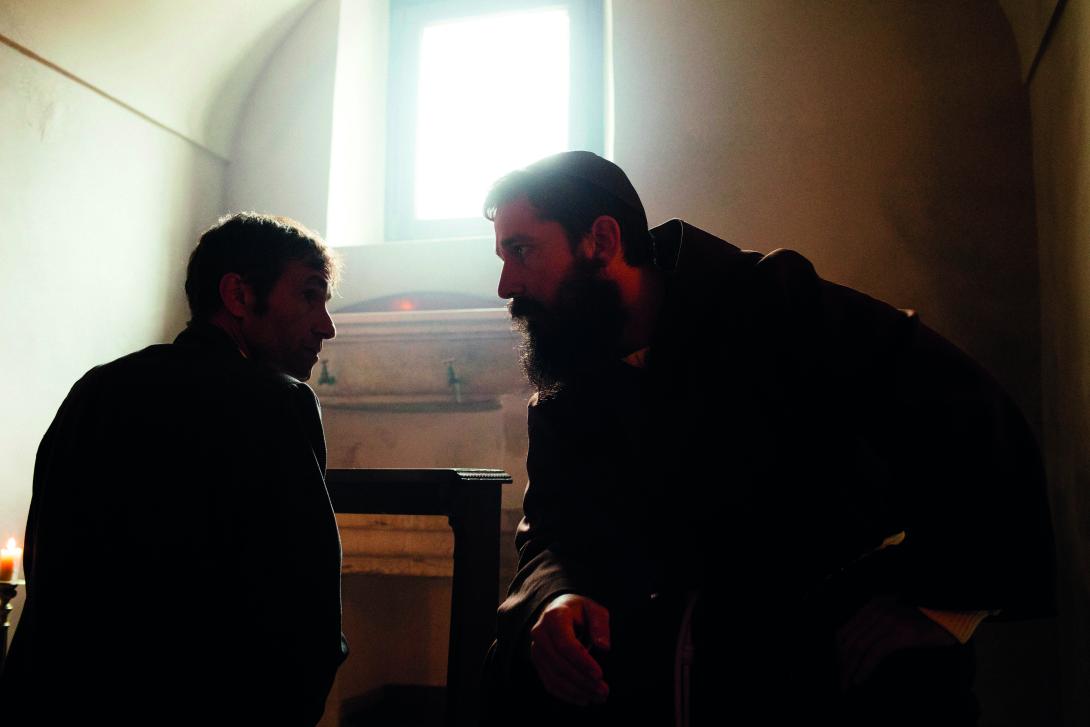Pio’s story seems to show that in the midst of all of the human secular drama, we are prompted to look for humble, often hidden signs of the Divine inbreaking

© Photo by Capstone Global
When one thinks of St. Padre Pio, I suspect a number of miraculous attributes come readily to mind. We think of his ability to bilocate, to read hearts and souls in the confessional, his conversations with his guardian angel, his dramatic and often physical wrestling matches with the Devil, and perhaps most of all, Pio the stigmatic, bearing the mystical wounds of the crucifixion. In this new film, Padre Pio, there is none of this, shy of a nod to the stigmata in the final scene. This may be intentional.
One way to interpret this film may be to shift our popular imagination away from all the supernatural baggage that is traditionally associated with Pio and to really encounter a man who is deeply human, humble, and deeply engaged in a spiritual battle. The film really is portraying two different stories. The first storyline concerns the townspeople emerging from the First World War. In the midst of a social and political vacuum, there is a battle between the working-class socialists attempting to spark a revolution and the ruling class of the town who are keeping a firm grip on power, land, and influence by any means necessary. Then there’s Padre Pio, played here ably by actor Shia LeBeouf. Arguably a minor character in the film, he occupies a second storyline, and the two do vaguely interact
Pio’s story seems to mirror certain aspects of the civil battle, in that Pio is engaged in a struggle with sin and evil. In a way, Pio is also fighting a spiritual battle for liberation and revolution.
Perhaps this mirroring was an intentional device meant to spark the viewers’ imaginations and reveal something about the human-spiritual journey. Namely, the two are intertwined, even if we do not see an immediate or obvious connection.
Pio’s story seems to show that in the midst of all of the human secular drama, we are prompted to look for humble, often hidden signs of the Divine inbreaking. We easily grasp onto the dramatic, and overwhelming signs: people who manifest miraculous wounds, or spout wisdom-laden prophecies, or people who seem to defy laws of physics. But this film seems to encourage us to keep faith that there are humble souls among us who are fighting very normal (and sometimes abnormal) human temptations and spiritual demons alongside the chaos of the world, simply praying for humanity’s liberation. It is the humility and humanity of Pio that shines forth, and beggars the question for those of us particularly devoted to this great saint: Is this image of Padre Pio, a poor friar who prays, enough? It is a question we could ask ourselves about every saint. Do we need to be amazed by signs and wonders, or can their bold and raw humanity and simple holiness suffice?
In the midst of Pio’s personal battles, we get allusions to his spiritual-psychological interactions with, we’re led to believe, the Evil One, or at least one of his legion. The passion of Pio in these moments is palpable, twice confronting and silencing these entities with the guttural invitation to declare, “Christ is Lord.” Apart from these disturbing interactions, we get very little in the way of highlighting the Capuchin life that would’ve shaped and inspired Padre Pio. Perhaps the most beautiful scene in this film is Pio celebrating the holy sacrifice of the mass and weeping in devotion at the altar. In the final scene, we get a nod to a mystical visitation between Pio and his Beloved. Hands meet, and wounds are visible. Clearly a visceral answer to Pio’s prayers and desires. In the end, the civil revolution is squashed with violence, and Pio takes on the wounds of sin in his flesh.
In the end, I am left wanting. It seems as though this would be an intriguing movie if it were framed as the first installment as we come to know Padre Pio in a greater way in subsequent films. As it stands, it was more driven by the surrounding civil-political drama and had Padre Pio take a humble secondary place in the film. A fitting place for a Capuchin friar. I am sure he would want it no other way.













